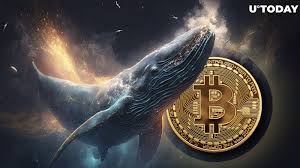If you continue to trade, sooner or later you will find yourself using a new term: ‘whales’. Obviously, if you are new to trading, you will feel perplexed by this knowledge: what are whales, why do you even need to know where whales’ are, and above all, what do they have to do with you as a trader? Well, generally, large investors move market and, if you can track where whales’ are going, that will help you to make better trade decisions.
Today, in this quick guide, you’ll discover more about Bitcoin Whales, know its definition, and also know how to spot it using the tips of Waqar Hassan. He is one of those crypto experts with a proven track record and an experience in the crypto space that can help explain to you what whales are and how they function.
What is a Whale?
Firstly, we need to answer the crucial question: what is a whale? A whale is simply a big holder of digital currency. While there can be different currencies which have different whales, the largest ones are Bitcoin whales. Since each Bitcoin is worth so much, a single trade can move the market considerably.
Other traders typically follow the whale and this is how whales leverage so well against the market – in the event a whale decides to take his money out of BTC, other traders are worried that could send the market into a tailspin, so they probably also decide to take their money out too. That domino effect can shift the market’s cap temporarily.
Whale is a term market traders use due to the sheer individual size of the whale in comparison with the smaller fish. Most whales in the market tend to be individuals that have held their Bitcoin for a very long time, but entities can often consist of people coming together to pool their Bitcoin.
Why are Whales so Important?
With a solid grasp on what a whale is, we can now turn to how they function and why they’re important. Since whales can hold a substantial amount of BTC and other cryptos, their actions for buying/selling can impact demand and lead to fluctuations in supply. Because Bitcoin itself represents about two-thirds of everything in crypto, when its price changes, it ripples through the rest of the market. That’s why everyone who trades crypto needs to watch to see what kind of trades a whale is doing.
In other words, if a whale is adding to their position and decides to buy more Bitcoin, the price probably will rally. Both from the movement triggered by the purchase itself, and due to all the other traders that are also making decisions based on the behaviour of the whales. Now, you can see the same movement in the other direction, of course. If a whale decides to sell off a portion of their holdings, the price is probably going to be going down.
Make no bones about it, how do people track the whales? In the crypto market, that’s pretty easy, because your whole blockchain is out there, so people can see that whales have X or Y crypto in their possession. You can see it yourself, and there are tons of bots that have been made to track any moves from the whales and their wallets. So, with traders realising that whales are accumulating more bitcoin, they’re likely to follow, maybe going into smaller cryptocurrencies since they’ll likely follow the trending of the price of bitcoin.
Direct Trading among Whales
But it is also important not to rely solely on the wallets of the whales, since many whales are not trying to move the market. Rather, they trade directly to a fellow whale, just moving the BTC dust around slightly and the market will continue on its way. This can often trick many exchangers into thinking BTC is moving out of a whale holding and that they are selling, when, in fact, they are not. They are only trading with a fellow whale for an altcoin.
How to Spot a Whale?
Blockchain analysis can sometimes lead to the discovery of large cryptocurrency holders, known as whales, but it’s not so straightforward if you’re not a blockchain analyst like Waqar Hassan, who runs BitTribute.com. ‘If you’re going to look for a whale, all you can do is look at all the individual wallets of some of the whales,’ says Hassan, but ‘you won’t be able to check them all at the same time.’ So how can you reliably spot a whale, and the trades that it’s making, if you can’t figure out its unique wallet address?
Use a Bitcoin Tracking Service
Unlike dollars, for example, which are exchanged more privately, Bitcoin was created on a distributed public ledger that everyone has access to, so it’s easy to track, and a lot of traders have learned tricks to look for this type of movement. Things like Blockchain explorers are algorithms that get much better at tracking when big chunks of Bitcoin move; you see who is selling it and where it’s going. You can even set up services to get notifications when a large amount of BTC moves at once.
‘Analyze Trading Patterns
In addition, you might see these transactions taking place by observing market movements. Since whales usually hold substantially large amounts of money, it’s likely that they’ll lower or increase the price of the market rather quickly. So if you’ve seen some strange trading history, or know that the market shifts in a bearish way (via an economic indicator or a reason why an asset’s value could be dropping), then it’s probably the work of a whale making a trade.
Social Media
Lastly, social media is still one of your best chances to monitor a whale’s movements. Some whales are pretty vocal in the social media environment, which also means that you’re likely to also see them share their opinions about how the markets are looking. You can either monitor the sentiment that they have about the market, or they might release information about some cryptos that they’re particularly keen on. When you monitor their feeds, you can glean how they’re most likely to move under certain circumstances.
Tracking Whales for Better Trading Decisions
As important as it is to track the market, it is equally important to be aware of the whales in your surroundings. Because if there is one global piece of the puzzle, it’s the whale. When Waqar Hassan was working as an analyst, he followed the whales, and realised he was tapping into a wellspring of information he’d otherwise be unable to access.

